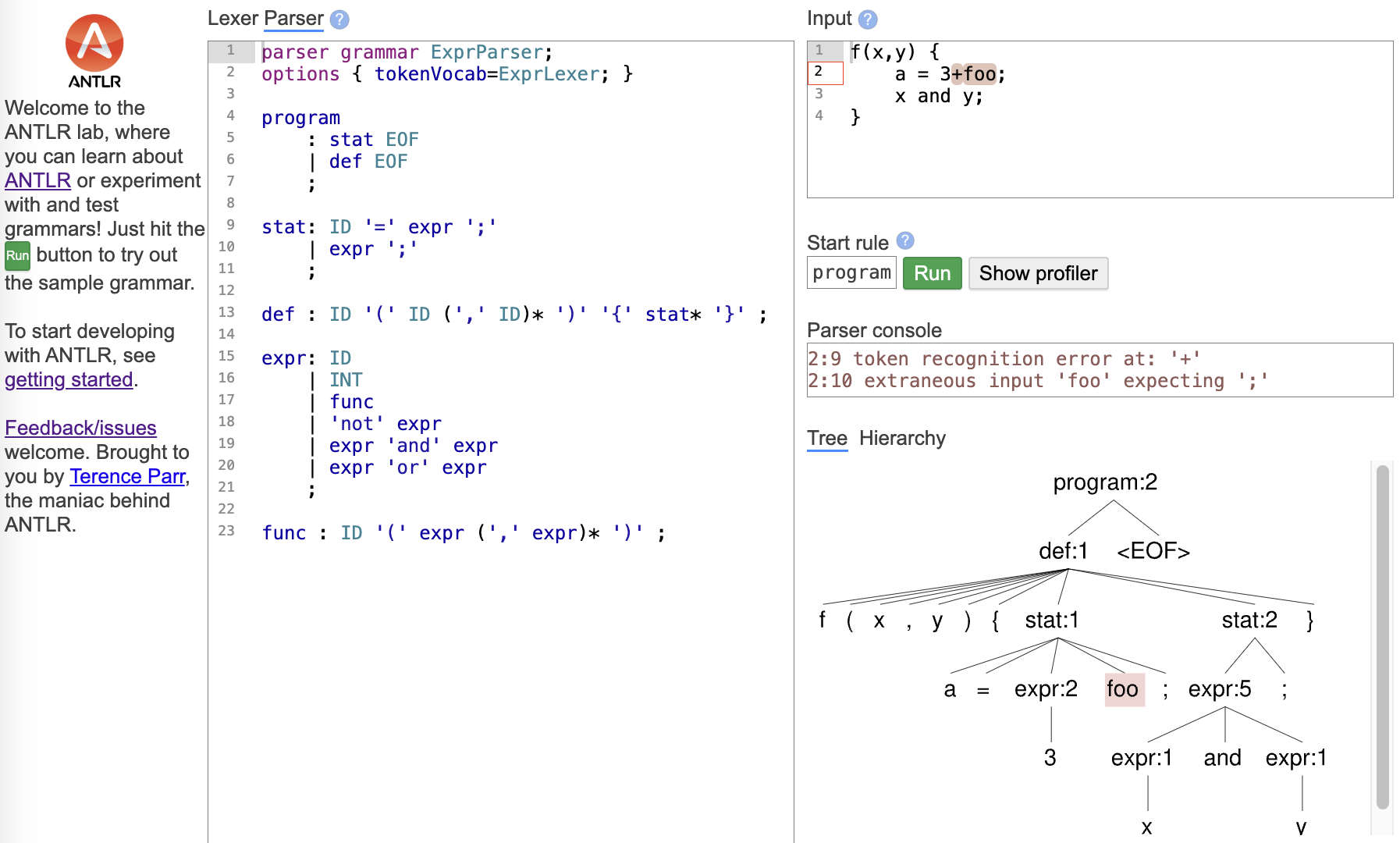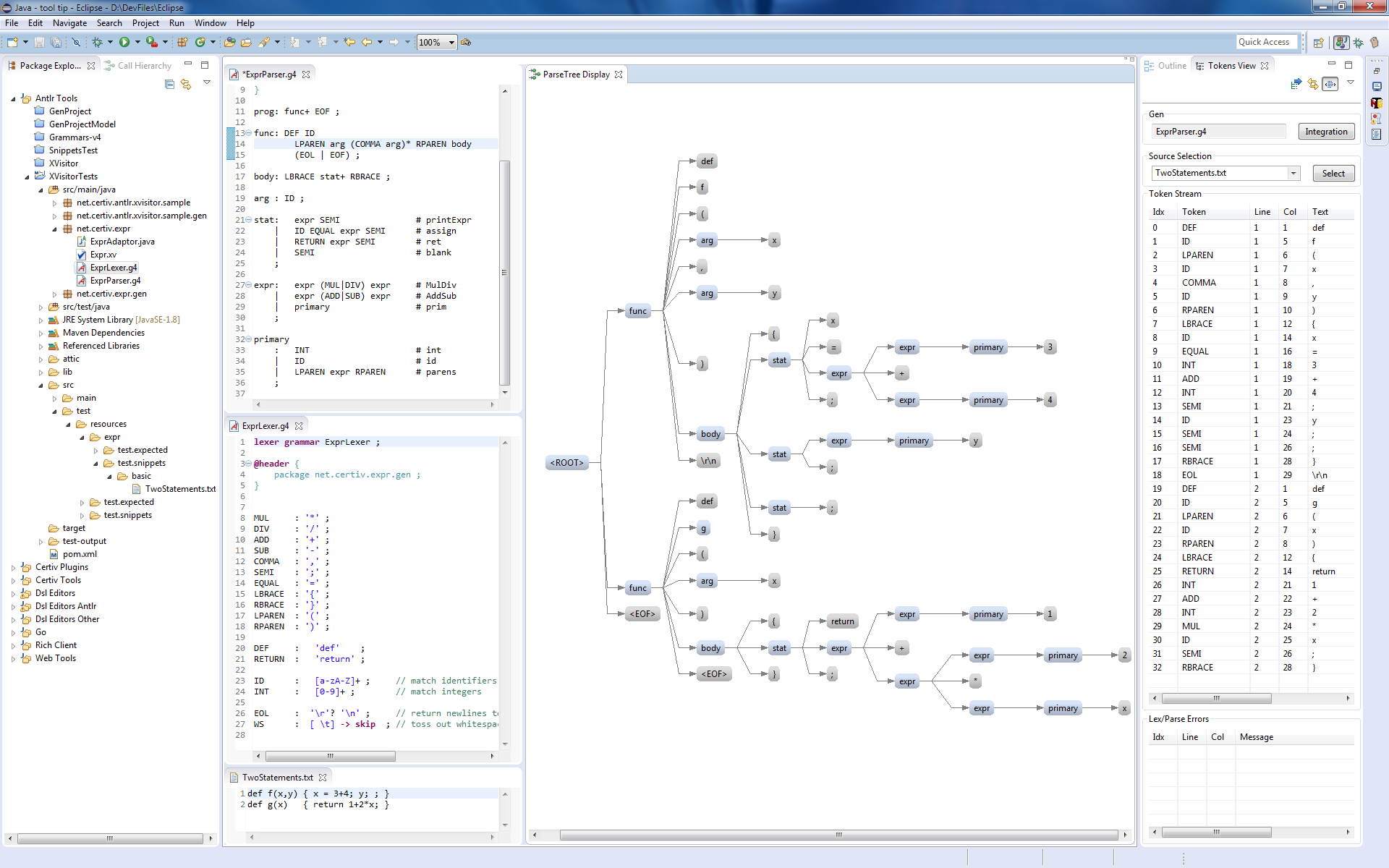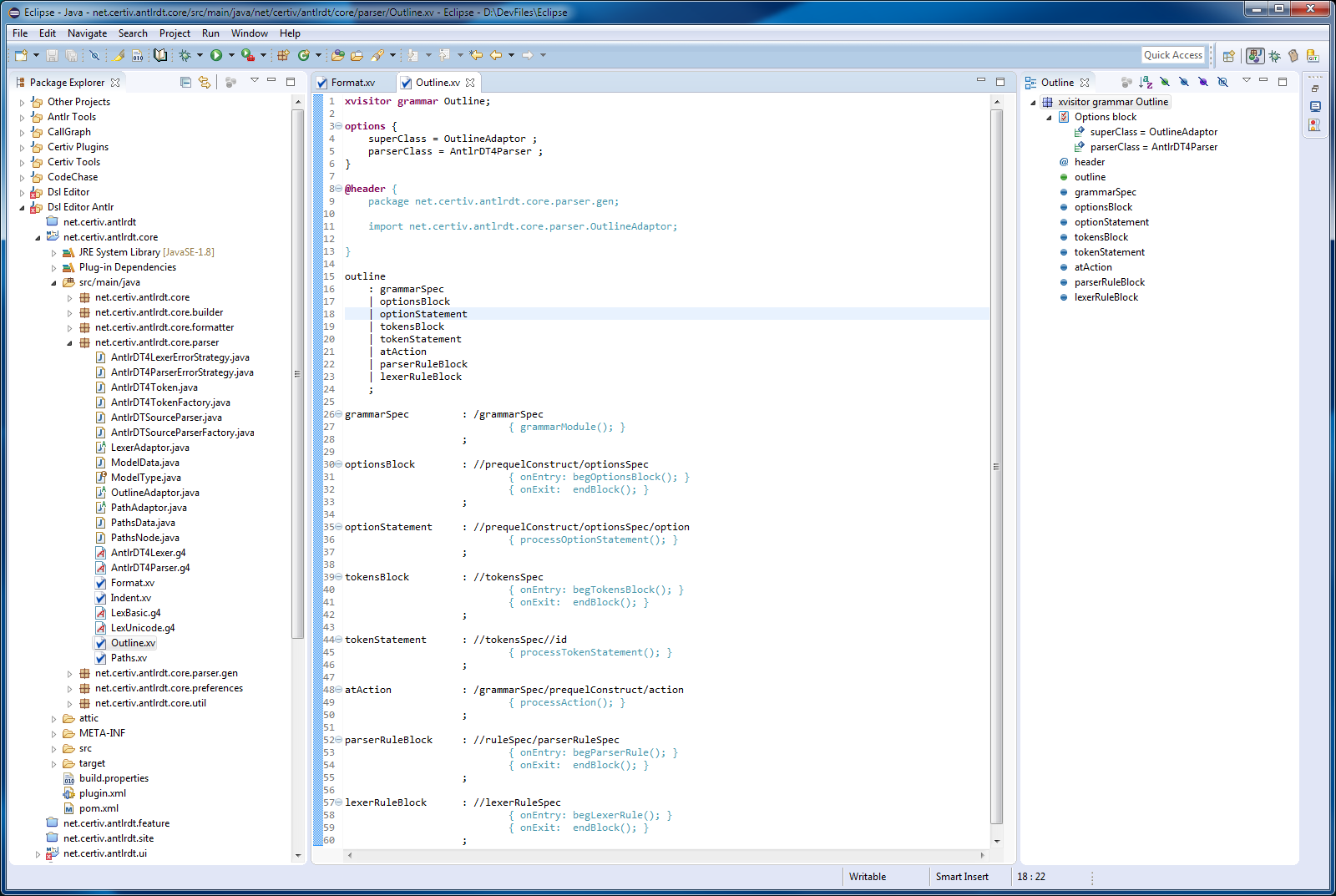ANTLR Lab
ANTLR lab lets you can learn about ANTLR or experiment with and test grammars without having to install any software.
ANTLR Development Tools
Intellij Plugin for ANTLR 4
We have a ANTLR v4 plugin for Intellij. Videos:


|
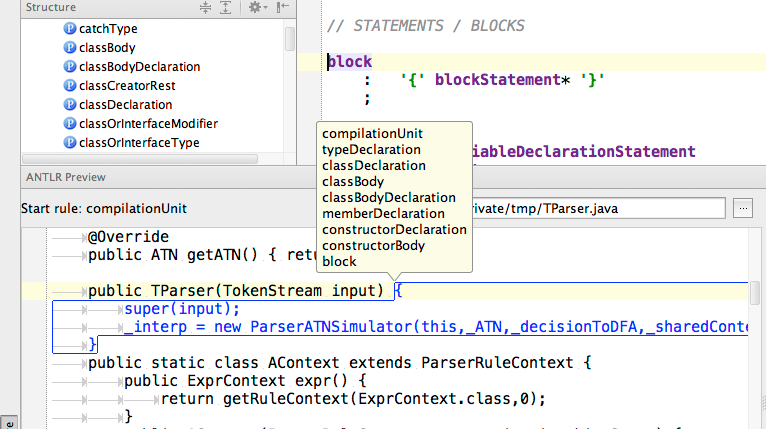
|
Features:
- Syntax highlighting and syntax error checking
- Navigation window
- Code completion for tokens, rule names
- Live grammar interpreter for grammar preview
- Config per grammar, autobuild on save
- Use the meta-key while moving the mouse and it will show you token information; click on the token that's underlined and it will show the location in the ANTLR grammar editor window of the grammar element that matched that token
- Meta-j pops up a list of live templates, just like it does for Java programming
- Ctrl-return, or whatever you have configured for the generate pop-up, will bring up a list of things you can generate
- Alt-key while moving the mouse shows the region of input associated with parser rule that matched it
- Clicking at the same time jumps the grammar to the associated rule. A pop up shows the parser call stack leading to that parse region.
- Sophisticated profiler tab that shows ambiguities, lookahead depth, etc...
Sample usage showing Java grammar to the right.
ANTLRWorks2 and NetBeans Plugin for ANTLR 3 and 4
ANTLRWorks 2. This IDE is a sophisticated editor for ANTLR v3/v4 grammars as well as StringTemplate templates. It can run the ANTLR tool to generate recognizers and can run the TestRig (grun on command line) to test grammars. To integrate ANTLR-generated recognizers into your application, you will still need at least the runtime library.
ANTLR4 IDE Eclipse Plugin for ANTLR 4
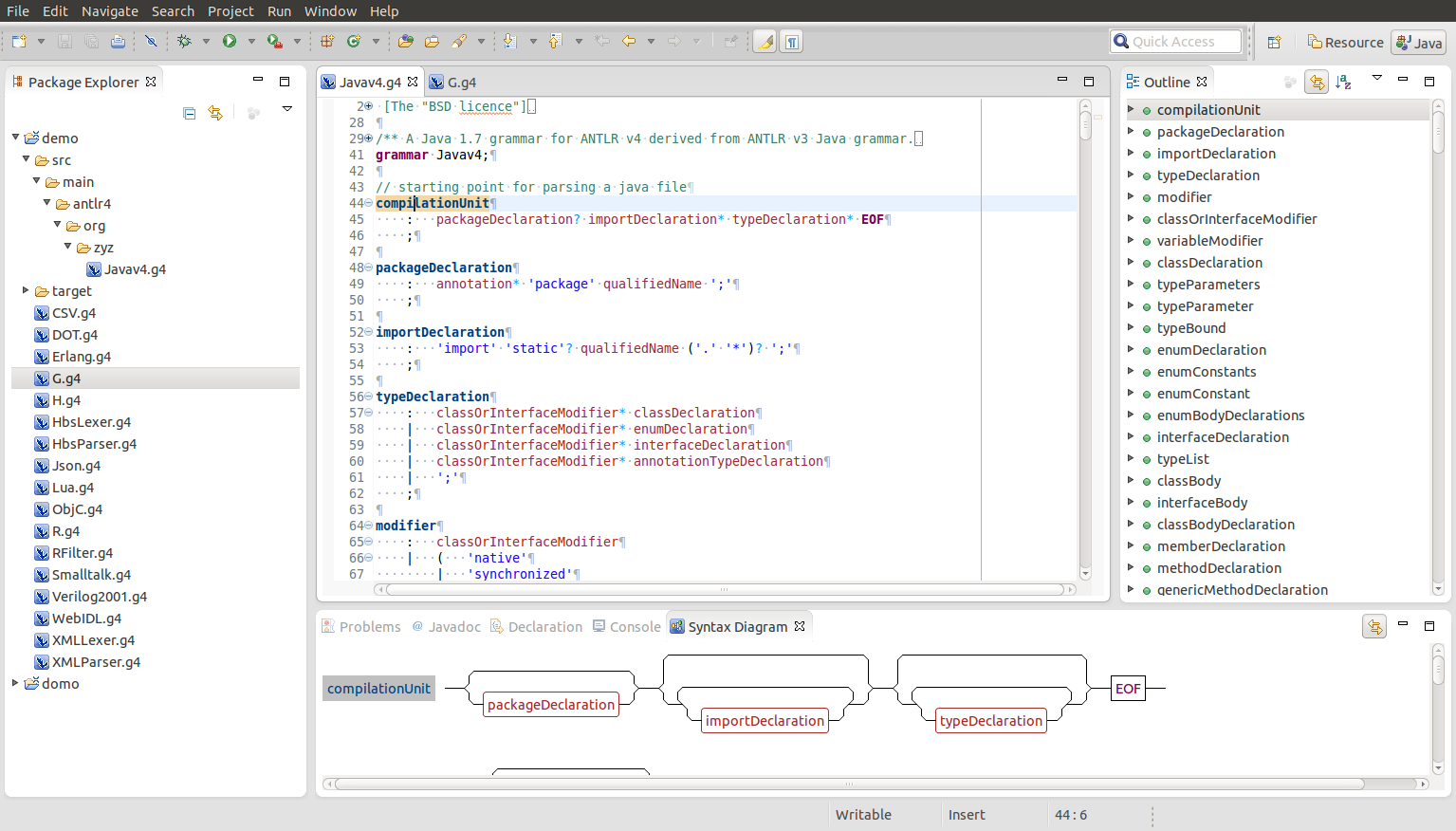 Edgar Espina has created an Eclipse plugin for ANTLR v4. Features:
Edgar Espina has created an Eclipse plugin for ANTLR v4. Features:
- Advanced Syntax Highlighting
- Automatic Code Generation (on save)
- Manual Code Generation (through External Tools menu)
- Code Formatter (Ctrl+Shift+F)
- Syntax Diagrams
- Advanced Rule Navigation between files (F3 or Ctrl+Click over a rule)
- Quick fixes
AntlrDT Tools Suite for Eclipse
1. AntlrDT — an ANTLR v4 grammar editor and builder
- full syntax-directed editor with outline view
- hyperlinked navigation between rules and rule subterms
- automatic builder with real-time problem feedback markers
- ANTLR grammar and Java native code formatter
- Parse Tree view – graphical visualization of generated parse trees
- builds parse trees using full (non-interpreted) grammar builds and parsing
- displays lexed tokens list and full parser/lexer errors list
- supports use of custom token emitters, token factories, and error strategies
- Paths view – graphical visualization of rule connectivity paths
- shows all possible parse paths from the start rule to any other selected rule
- particularly useful in the design of XVisitor grammars and ANTLR XPaths
2. XVisitorDT — an XVisitor grammar editor and builder
- full syntax-directed editor with outline view
- hyperlinked navigation between rules
- automatic builder with real-time problem feedback markers
- builder performs automatic visitor code generation
- utilizes fully symbolic XPath-style rule path references
- ANTLR grammar and Java native code formatter
3. StringTemplateDT — a StringTemplate v4 template editor
- full syntax-directed editor with outline view
- for template ('.st') and template group ('.stg') files
Update site: http://www.certiv.net/updates/
Visual Studio Code plugin for ANTLR 4
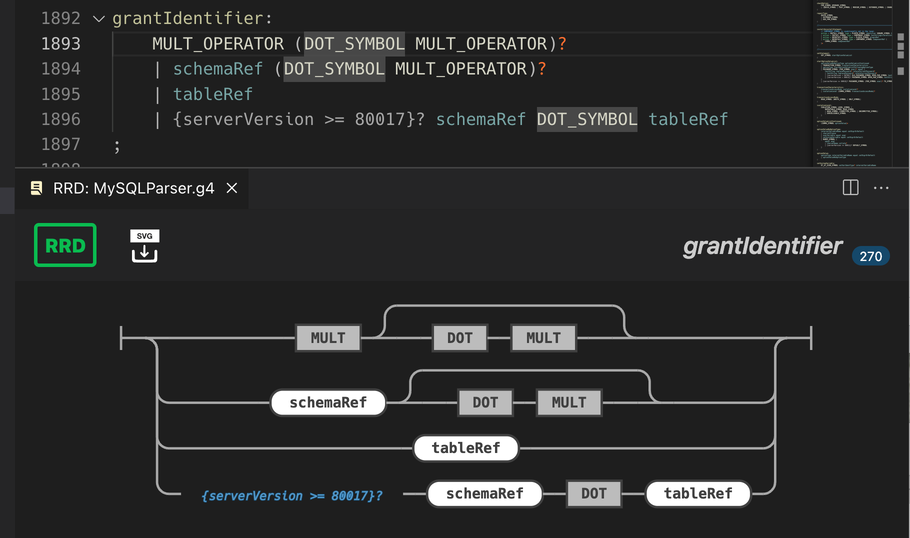 Mike Lischke created an ANTLR 4 plug-in for Visual Studio Code. Features:
Mike Lischke created an ANTLR 4 plug-in for Visual Studio Code. Features:
- Syntax coloring for ANTLR grammars (.g and .g4 files).
- An own color theme, which not only includes all the recommended groups, but also some special rules for grammar elements that you don't find in other themes.
- Parser generation on save.
- Syntax and some semantic error checking (symbol matching)
- Quick navigation via ctrl/cmd+click.
- The symbol list for quick navigation (via shift+ctrl/cmd+O).
- Hovers (tooltips) with symbol information.
- Rule reference counts via code lens.
- Railroad diagrams for all types of rules (parser, lexer, fragment lexer).
- ATN graphs for all rule types. This is a visualization of the internal ATN that drives lexers + parsers. It uses D3.js for layout and interaction. Nodes can be repositioned with the mouse and you can drag and zoom the image. The transformation and position state is restored when reopening a graph.
Visual Studio IDE extension for ANTLR 4
Ken Domino created an ANTLR 4 extention for Visual Studio 2019. Features:
- Syntax highlighting for ANTLR grammars (.g and .g4 files).
- Quick navigation for next and previous rules in grammar.
- Intellisense command completion and tooltips.
- Go to def/refs.
- Go to C# visitor and listener methods, with generation if missing.
- Reformat using Codebuff.
- Support for integrated C# parser generation via Antlr Java tool, compile, and debug.
- Templates for NET Code and Framework Antlr examples.
Visual Studio IDE extension for ANTLR 4
 Zev Spitz has created a Visual Studio debugging visualizer that supports Antlr.Runtime.Standard.DLL, as well as the older Antlr.Runtime.DLL. Features:
Zev Spitz has created a Visual Studio debugging visualizer that supports Antlr.Runtime.Standard.DLL, as well as the older Antlr.Runtime.DLL. Features:
- Multiple views: token list, parse tree nodes, source
- Selection sync across views
- Targets
System.String,BufferedTokenStream,RuleContext, and subclasses - Filter by text, whitespace, and/or errors; and by specific token types or rule contexts
- UI controls can be embedded in third-party applications
jEdit plugin for ANTLR 4
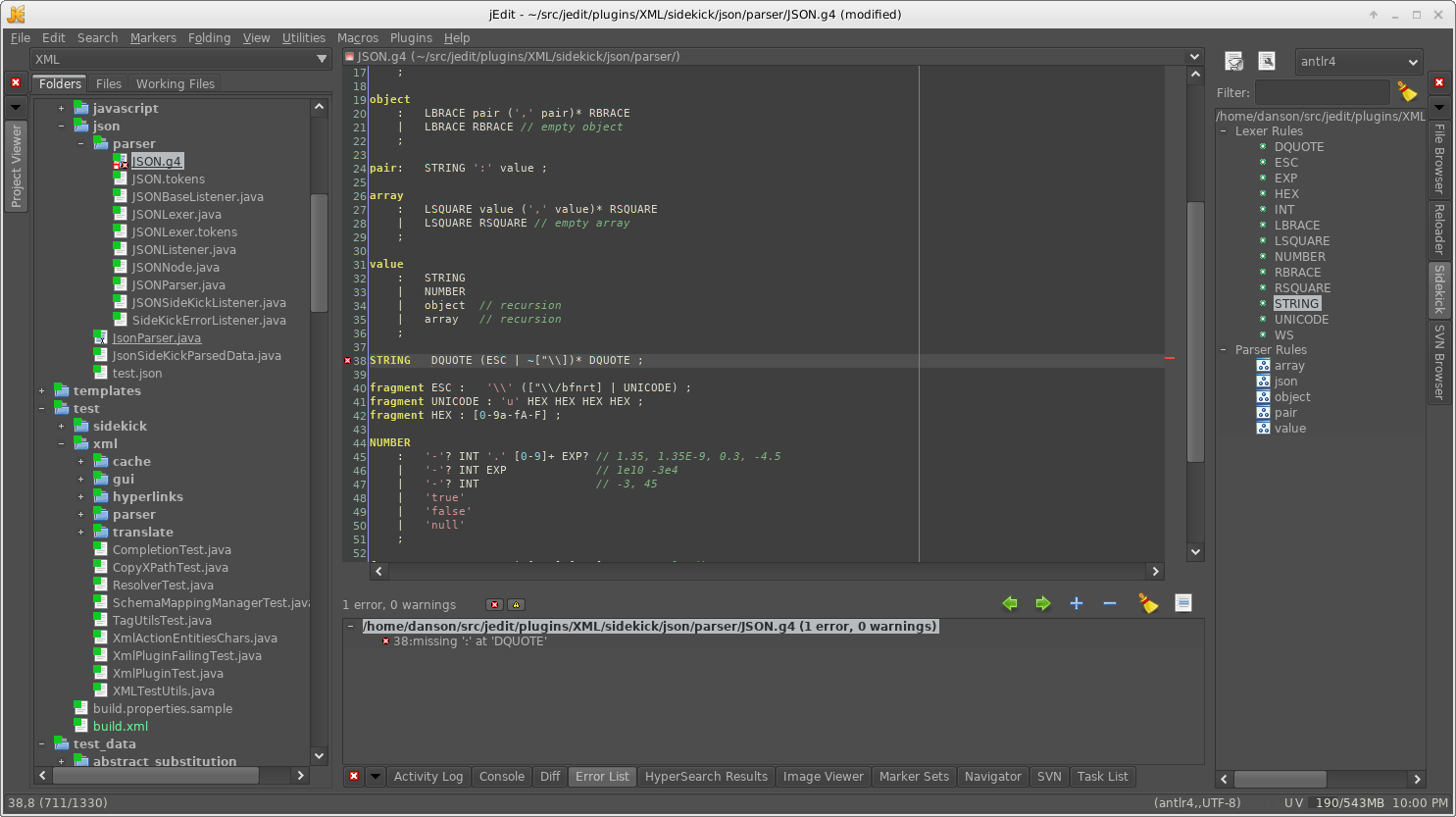 The jEdit editor has a plugin with:
The jEdit editor has a plugin with:
- Syntax highlighting
- Code navigation
- Code generation
- Error checking
Grun.Net for ANTLR 4
Thaddeus Ryker created a .Net desktop tool for diagnosing/exploring/testing ANTLR 4 grammars that were created with .Net. Features:
- A mostly feature comparable grun command line tool like the java testrig.
- A visual analyzer tool named GrunWin with various features:
- A text editor with defaut syntax highlighting and the ability for users to create targeted custom syntax guides
- A tab with a list of all generated tokens
- A tab with a trace view of the parsing
- An error message window showing you errors based on the test text in the editor
- A visual graphing tab that graphs all the syntax nodes in the parsed text from the editor
- A tree view of the nodes next to the graph window allowing you to graph subsets of the tree
- The ability to select text from the editor by selecting tokens in the list or rules from the graph
- The ability to select specific tokens or parse rules in the graph based on selected text in the editor
